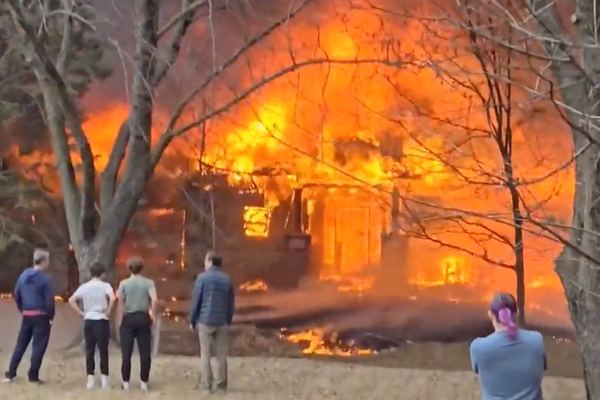If you are a lightning bug fan who didn’t get tickets to this year’s Pennsylvania Firefly Festival in the Pennsylvania Wilds, you’re in good company.
Unlike the early days, when any and all were welcome to come watch the rare synchronous display of male Photinus carolinus blinking in unison — it drew more than 1,000 people on one night in 2016 — the annual fest held on Peggy and Ken Butler’s farm in Kelletville, Forest County, now allows just 100 attendees over two days. Which explains why the 2022 festival sold out in less than 5 minutes on May 1.
People came from all across the U.S. and even overseas (fireflies are especially popular in Asia).
“It was just unmanageable on our end with our small group of volunteers,” says Ms. Butler, who is a speech and language pathologist for the Forest County School District.
And with so many feet tromping through the woods at one time, the crowds endangered the unique environment that makes this patch of Pennsylvania woods near Tionesta one of just a handful of places across the globe to find synchronous fireflies.
“We realized there were way too many people, causing habitat destruction,” says festival board member Jeff Calta of Chicora.
Scientists warned against exactly that when the rare beetles were discovered there in 2012 by a group of environmentally savvy campers, and the idea of a festival was born.
Perhaps fortuitously, social distancing restrictions put in place during the pandemic allowed the festival — created as a nonprofit organization in 2013 — to “hit the reset button” while also making it a more intimate experience for those lucky enough to get one of the $50 tickets.
Disappointing, for sure, but you can still support the festival’s mission through a new initiative launched this year.
The “Lights Out for Lightning Bugs” campaign kicks off Sunday with the goal of promoting the conservation and protection of fireflies across the state. To help the bugs find each other in your yard and reproduce, festival organizers ask people to turn off or shade their porch and outside lights for at least through Saturday, June 25.
Much of the world is losing its firefly populations due to light pollution, Calta notes, and the indiscriminate use of pesticides and insecticides is also taking a toll on the bug the state of Pennsylvania designated its official insect in 1974.
Like all beetles, fireflies goes through four life stages over two years — egg, larva, pupa and adult. They spend most of that time underground in lawns, grassy patches and forest where you’re unlikely to see them. So soil health is very important with regards to their development.
In addition, adults live only two weeks and females tend to be poor flyers, so they stay in the grass or low shrubbery, where feet can crush them.
Light pollution is a bigger danger. Light of any color — whether from a porch light or the artificial illumination created by urban sprawl — essentially shuts down the flashing replies of females to attract mates.
If fireflies are blinded by lights (especially white and amber lights) or their flashes are overpowered by extensive and prolonged light intrusion, they cannot find a mate and the next generation is lost.
“The adult firefly is designed for one thing only — mating,” says Calta, a student of fireflies who has helped the Butlers for several years with the festival. “They don’t eat or drink. They just get up at night to do their flying and mate.”
The females then lay their eggs in a mossy area. When then they hatch in the fall, the larvae burrow into the soil and stay there for one or two years until something triggers them to become adults.
In addition to dimming outside lights, you can help foster future generations of fireflies by not spraying pesticides on your lawn and leaving areas unmowed so the insects have a chance to thrive in a safe habitat. Raking fall leaves into a pile can also help fireflies to survive the winter.
“We want to be sure we pay attention to not just lightning bugs flying around in summer, but the whole cycle,” says Ms. Butler.
Which brings us back to the roots of the Pennsylvania Firefly Festival.
Lots of people on the East Coast grow up with Photinus pyralis, the most common of some 2,000 known species of lightning bugs. No one realized that synchronous fireflies live in the Allegheny National Forest until a group of campers spotted them in the night sky in June 2011 and alerted a firefly research group known as the FIRE Team (Firefly International Research & Education).
Naturalist Lynn Frierson Faust helped scientists identify the Western Hemisphere's first synchronous fireflies in the Great Smoky Mountains in 1992. She came to the Butlers’ Black Caddis Ranch B&B in 2012 for 10 days to conduct research.
All species have their own individual flashing patterns. Common eastern male fireflies, which fly low to the ground at a leisurely pace starting at dusk, flash every 5 seconds or so and then wait for the females in the grass to respond.
Synchronous fireflies are the only ones that coordinate their flash patterns. They light up together in short random bursts from six to eight times for about 8 seconds before going dark, and then repeat the cycle. On a good night, when it’s warm and quiet and the moon’s not too bright, the sparkling show can includes thousands of fireflies.
“We didn’t know there was more than one kind of lightning bug,” let alone the 15 species found in Pennsylvania, Ms. Butler recalls with a laugh.
The scientists promised to keep the fireflies secret if that’s what the couple wanted. But the discovery also presented an opportunity for education and tourism so long as the Butlers educated themselves and were aware of the dangers of crowds.
Naively thinking only a handful of people would travel all way to Forest County just to see some fireflies, they chose the latter, and launched the festival in 2013. To their surprise, hundreds showed up and it grew every year.
With festival attendance now limited, the Pennsylvania Firefly Festival has added three “Glow & Know” firefly campouts at locations outside Forest County to their event list, complete with a campfire, hotdogs, s'mores and music followed by the late evening program and searching for fireflies. But they are limited to 10 campers each and like the festival, all three sold out almost immediately on May 1.
The group also offers educational materials, displays and slide presentations to schools and special interest groups.
Thanks to a rise in firefly tourism across the U.S., the Xerces Society has created guidelines and is providing support through the newly formed US Firefly Tourism Luminary Council, composed of volunteers from a variety of public and private tourism providers to identify and address threats to their population.
“And we’ve had some discussions about how to protect and preserve fireflies and use responsible tourism,” says Ms. Butler, who attended the 2022 International Firefly Symposium last week in Parque Biologico de Gaia, Portugal, to further her own education.
And if you want a ticket to the 2023 festival? She suggests signing up for PAFF’s free quarterly newsletter because subscribers get early notification of the links to registration. “And the day it goes live, you’ll have a jump on” one of the 150 available slots, including the campouts.
There is a dark side to fireflies — some carnivorous females, in a femme fatale move, flash fake mating signals to attract males so they can eat them — but most people love them because they’re “just so charming,” Ms. Butler says.
Watching lightning bugs float around in the night sky like twinkling fairies is incredible, she says, and brings back so many childhood memories. “And believe me, I’m not a bug person!”







